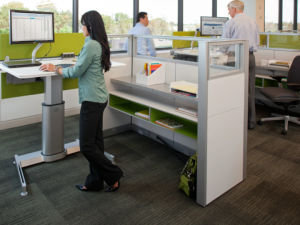Recently the NY Times published an opinion piece with the provocative title “Why You Hate Work”
Once you get past the title and the accompanying cartoon (what’s the deal with the guy with the paper airplane anyways?), what you have is a well-written article about the perils of ignoring workplace health and, further, that there is plenty of room for improvement out there.
When we engage with our clients about how their spaces need to change to support their evolving business issues we see a very definite pattern in terms of the workplace issues that they are experiencing. Invariably, these include:
- Real Estate Optimization
- Attract, develop and engage talent
- Enhancing Collaboration
- Build and support brand and culture
- Wellbeing at work
Organizations have always been interested in real estate and attracting talent, and in the last decade or so, work process and organizational structures have put a premium on collaboration. And, many have taken a cue from high performing companies like Google, Accenture, and others that recognize that you cannot hope to successfully communicate your brand externally if you are not first communicating it internally. But the fifth workplace issue, Wellbeing at Work, is a relatively new one that we’re beginning to hear much more about. It is of interest for a number of reasons – a large one being the cost implications, as well as the need to engage employees when the business environment is more competitive than ever before. Also, this is an economic issue. Of course, with healthcare costs being what they are, this is obvious. But there is more to it as well. Tom Rath, best selling author wrote in Wellbeing: The Five Essential Elements, “Just as the most successful organizations have worked systemically to optimize their levels of employee engagement, they are now turning their attention to employee wellbeing as a way to gain an emotional, financial, and competitive advantage.”
So, is it really possible? Can the workplace actually be a place where people leave healthier than when they arrive in the morning? Why not? After all, you can go to a theatre and do nothing better than sit for a few hours and come out uplifted and inspired. So why not get inspired at the office?
 Too often we think of workplace health we limit our concern to repetitive motion injuries and chairs with poor support. But it is so much more than that. A healthy employees is an inspired, active, consulted, empowered employee that is provided with the tools, access and information to get their work done. Of course, we would suggest a well designed workplace (with a good chair!) is part of this equation.
Too often we think of workplace health we limit our concern to repetitive motion injuries and chairs with poor support. But it is so much more than that. A healthy employees is an inspired, active, consulted, empowered employee that is provided with the tools, access and information to get their work done. Of course, we would suggest a well designed workplace (with a good chair!) is part of this equation.
A productive and healthy employee need to be in an inspired environment that provides a range of work setting for how and what they do. And for so many organizations that is different now than in the past.
So, is your workplace ready? Does it:
- Create settings that encourage socialization and collaboration and help people feel a part of the organization?
- Create zones that amp up or down the amount of sensory stimulation – from bustling activity to quiet concentration
- Design spaces to encourage a variety of postures – sitting, standing, perching, and even walking
If not, then you can do better. And you need to unless you want to risk being uncompetitive in a marketplace that is more and more competitive every day.

